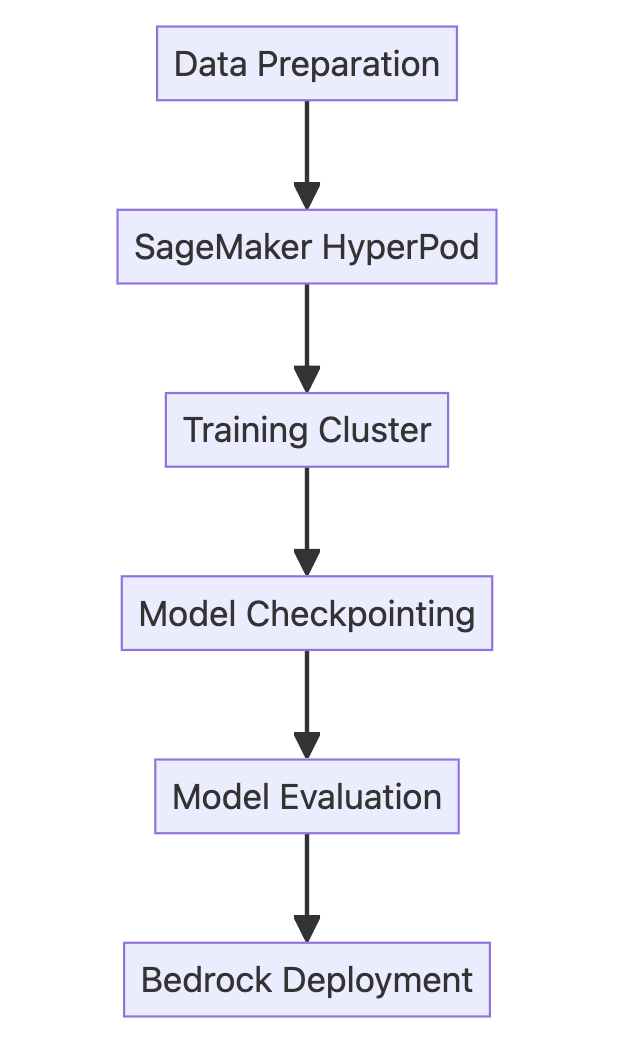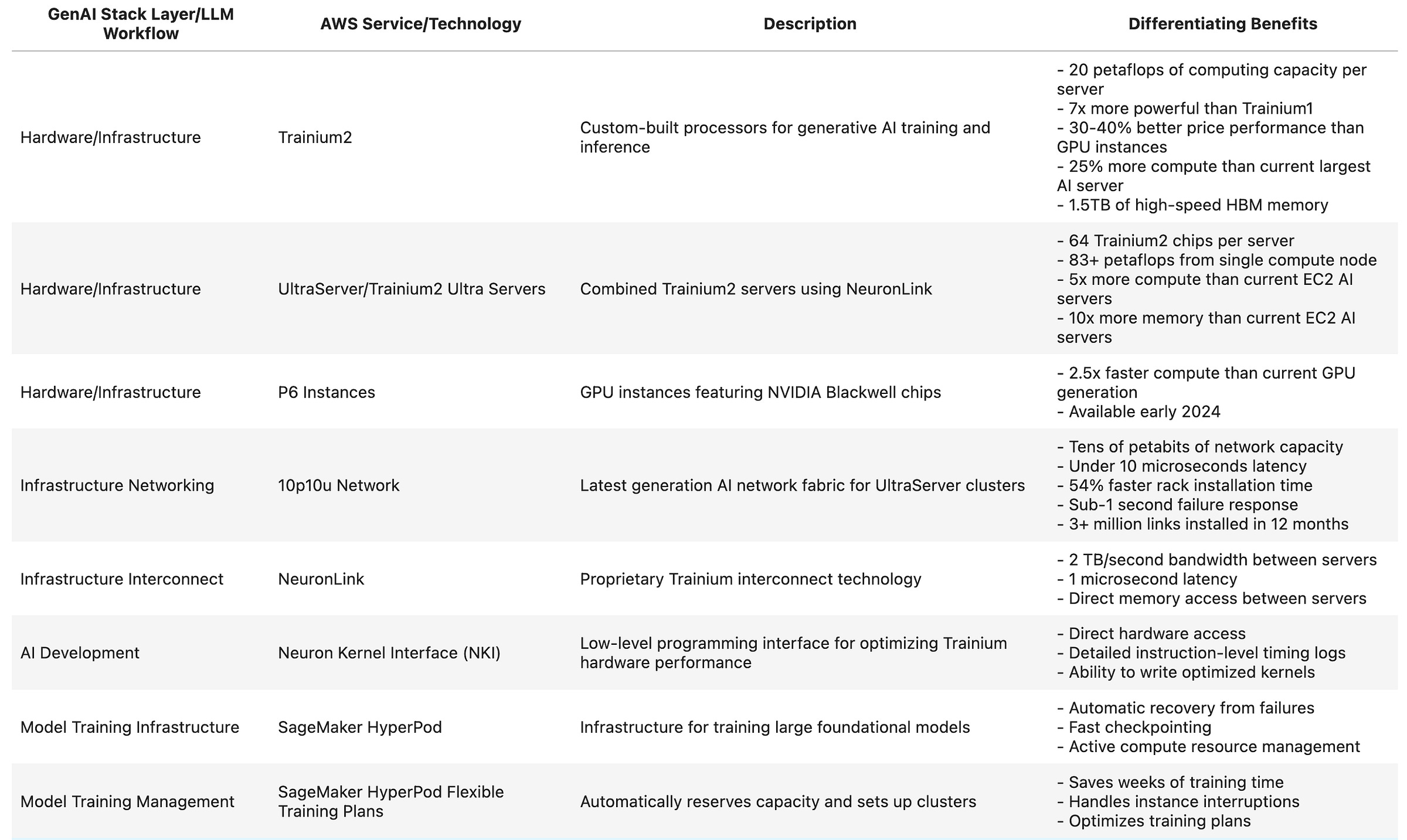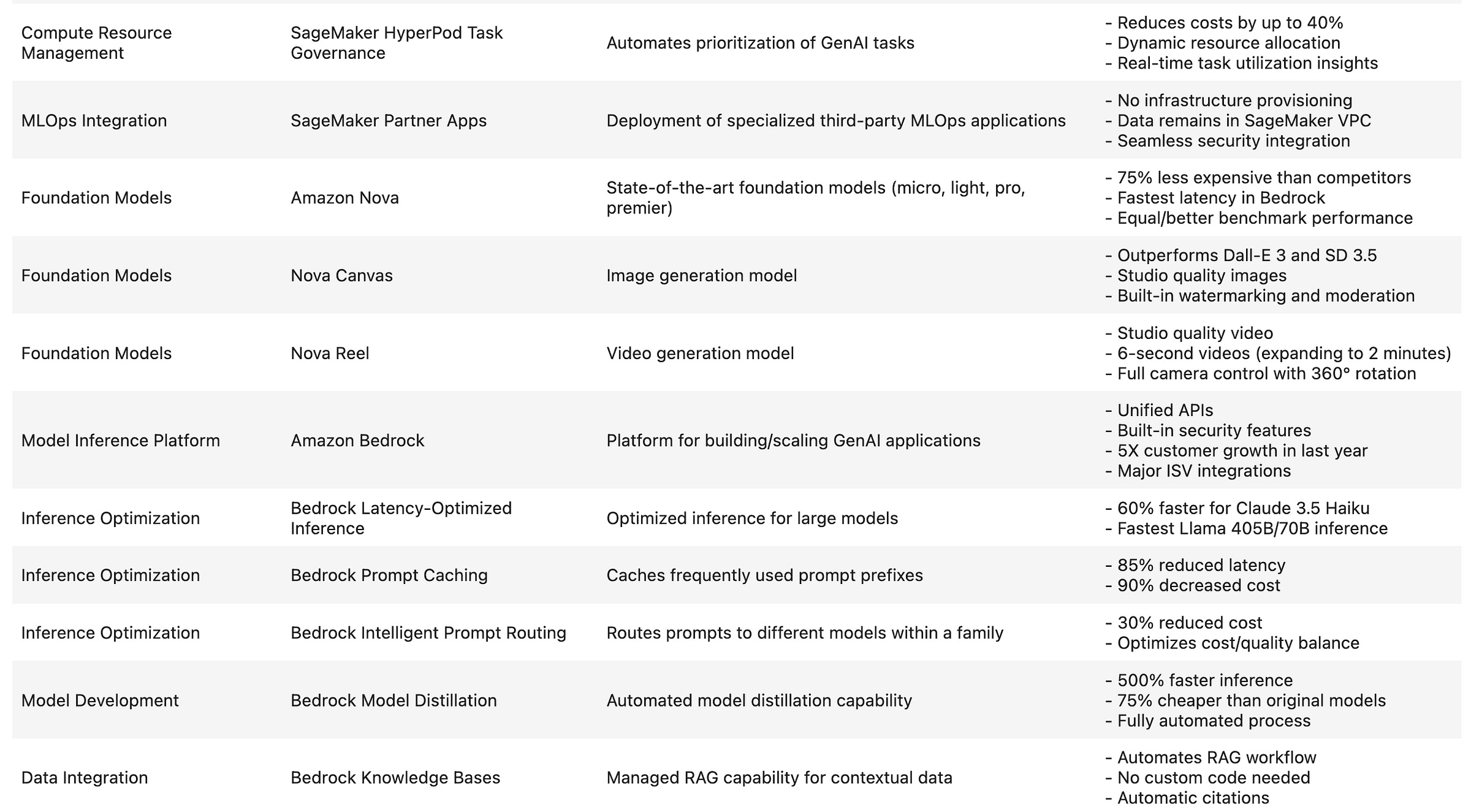AWS GenAI Stack: A Primer for LLM Development and Deployment
AWS has built a comprehensive suite of services and technologies to support the entire LLM workflow
The development and deployment of Large Language Models (LLMs) requires a sophisticated technology stack. AWS has built a comprehensive suite of services and technologies to support the entire LLM workflow. Let's explore each component following the natural progression from infrastructure to application deployment.
The Section 1 content is written like a mini paper on Building an LLM on AWS contrasting two approaches of building an LLM from scratch as well as distilling a student LLM using a base frontier LLM.
The Section 2 content in this article compresses insights from several hours of keynotes at the largest cloud event in the world, re:Invent 2024. So if you missed the updates from Las Vegas, I have you covered. This article summarizes more that 60 AWS technologies and services mentioned during the keynotes which directly relate to LLM workflows and Generative AI.
Listen to AI moderated podcast based on this article
Section 1: Building an LLM on AWS
Executive Summary
This paper examines two approaches to implementing LLMs on AWS using the latest infrastructure and services announced at re:Invent 2024.
Full-scale training of frontier models
Knowledge distillation using existing models
1. Training Frontier LLMs from Scratch
1.1 Infrastructure Stack
The foundation relies on AWS's new AI infrastructure:
Trainium2 processors delivering 20 petaflops per server
UltraServer clusters with 64 Trainium2 chips providing 83+ petaflops
10p10u Network fabric with sub-10 microsecond latency
NeuronLink interconnect enabling 2 TB/second bandwidth
1.2 Training Architecture
1.3 Implementation Workflow
Infrastructure Setup
Deploy SageMaker HyperPod
Configure Flexible Training Plans
Implement Task Governance for resource optimization
Training Pipeline
Utilize Neuron Kernel Interface (NKI) for hardware optimization
Implement automatic recovery mechanisms
Leverage fast checkpointing capabilities
Deployment and Inference
Deploy through Amazon Bedrock
Implement Latency-Optimized Inference
Enable Prompt Caching for 85% latency reduction
2. Knowledge Distillation Approach
2.1 Architecture Overview
2.2 Implementation Process
Teacher Model Setup
Deploy Llama model through Bedrock
Configure inference optimization settings
Distillation Pipeline
Utilize Bedrock Model Distillation
Achieve 500% faster inference
Reduce costs by 75%
3. Comparative Analysis
3.1 Resource Requirements
Frontier Training: Requires full UltraServer clusters
Distillation: Significantly lower compute requirements
3.2 Development Complexity
Frontier Training: Highest complexity, requires NKI expertise
Distillation: Automated process through Bedrock
3.3 Cost Implications
Frontier Training: Highest infrastructure investment
Distillation: 75% cost reduction compared to original models
4. Best Practices
4.1 Security and Governance
Implement Bedrock Guardrails
Use content filters and grounding
Maintain topic boundaries
4.2 Monitoring and Optimization
Leverage SageMaker HyperPod Task Governance
Monitor real-time utilization
Implement dynamic resource allocation
5. Conclusion
The choice between full training and distillation depends on specific use cases:
Full training offers complete control but requires significant resources
Distillation provides efficient deployment with reduced costs
Both approaches benefit from AWS's integrated GenAI stack
The paper is based on the AWS services information provided in the document. For implementation details, specific configurations, and current best practices, please consult the latest AWS documentation and technical resources.
Section 2: AWS GenAI Stack
Infrastructure Layer: The Foundation
Hardware Innovation
AWS has made significant strides in AI-specific hardware with the introduction of Trainium2 chips. These custom-built processors deliver impressive capabilities.
AWS Trainium2 represents AWS's next-generation AI accelerator.
According to AWS: "Amazon EC2 Trn2 instances, powered by 16 AWS Trainium2 chips, are purpose-built for generative AI and are the most powerful EC2 instances for training and deploying models with hundreds of billions to trillion+ parameters. Trn2 instances offer 30-40% better price performance than the current generation of GPU-based EC2 P5e and P5en instances. With Trn2 instances, you can get state-of-the-art training and inference performance while lowering costs, so you can reduce training times, iterate faster, and deliver real-time, AI-powered experiences. You can use Trn2 instances to train and deploy models including large language models (LLMs), multimodal models, and diffusion transformers to build next-generation generative AI applications."
The new Trainium2 chips deliver:
20 petaflops of computing capacity per server
7x more powerful than their predecessor
30-40% better price performance than GPU instances
1.5TB of high-speed HBM memory
AWS EC2 Trn2 UltraCluster combines multiple Trainium2 servers into powerful compute clusters.
“AWS UltraCluster is purpose-built to train foundation models with hundreds of trillions of parameters. It combines AWS Trainium2 chips with a high-performance fabric called AWS 10/10 (10 petabit/s bandwidth, 10 microsecond latency) to deliver the highest performance training infrastructure in the cloud”, as described by AWS.
Networking and Interconnect
The infrastructure is tied together with:
10p10u Network: Providing tens of petabits of capacity with sub-10 microsecond latency. This also enables 54% faster rack installation and sub-1 second failure response
NeuronLink: Proprietary interconnect technology offering 2 TB/second bandwidth between servers
Benefits of NeuronLink are described by AWS here:
"To lower training times and deliver breakthrough response times (per-token-latency) for the most demanding, state-of-the-art models, you might need more compute and memory than a single instance can deliver. Trn2 UltraServers use NeuronLink, the AWS proprietary chip-to-chip interconnect, to connect 64 Trainium2 chips across four Trn2 instances, quadrupling the compute, memory, and networking bandwidth available in a single node and offering breakthrough performance on AWS for deep learning and generative AI workloads. For inference, UltraServers help deliver industry-leading response time to create the best real-time experiences. For training, UltraServers boost model training speed and efficiency with faster collective communication for model parallelism as compared to standalone instances."
Model Training Infrastructure
SageMaker HyperPod
The benefits of Amazon SageMaker HyperPod are described by AWS as:
"With SageMaker HyperPod, you can efficiently distribute and parallelize your training workload across all accelerators. SageMaker HyperPod automatically applies the best training configurations for popular publicly available models, to help you quickly achieve optimal performance. It also continually monitors your cluster for any infrastructure faults, automatically repairs the issue, and recovers your workloads without human intervention—all of which help save you up to 40% of training time."
Key features include:
Automatic failure recovery with checkpoint management
Flexible training plans that save weeks of training time
Task governance reducing costs by up to 40%
Integration with popular ML frameworks
Managed Foundation Models and Inference
Amazon Bedrock
Amazon Bedrock is AWS's fully managed service for foundation models. According to AWS:
"Using Amazon Bedrock, you can easily experiment with and evaluate top FMs for your use case, privately customize them with your data using techniques such as fine-tuning and Retrieval Augmented Generation (RAG), and build agents that execute tasks using your enterprise systems and data sources. Since Amazon Bedrock is serverless, you don't have to manage any infrastructure, and you can securely integrate and deploy generative AI capabilities into your applications using the AWS services you are already familiar with."
Bedrock's Features include:
Latency-Optimized Inference: 60% faster for models like Claude 3.5 Haiku
Prompt Caching: Reducing latency by 85% and costs by 90%
Intelligent Prompt Routing: 30% cost reduction through optimal model selection
Model Distillation: Achieving 500% faster inference at 75% lower cost
Data Integration and Knowledge Management
Knowledge Bases and RAG
Amazon Bedrock Knowledge Bases use cases are described as:
"With Amazon Bedrock Knowledge Bases, you can integrate proprietary information into your generative-AI applications. When a query is made, a knowledge base searches your data to find relevant information to answer the query. The retrieved information can then be used to improve generated responses. You can build your own RAG-based application by using the capabilities of Amazon Bedrock Knowledge Bases."
Amazon Kendra GenAI Index enhances enterprise search capabilities using GenAI:
"Amazon Kendra GenAI Index is a new index in Kendra designed for retrieval-augmented generation (RAG) and intelligent search to help enterprises build digital assistants and intelligent search experiences more efficiently and effectively. This index offers high retrieval accuracy, leveraging advanced semantic models and the latest information retrieval technologies. It can be integrated with Bedrock Knowledge Bases and other Bedrock tools to create RAG-powered digital assistants, or used with Q Business for a fully managed digital assistant solution."
Features include:
40+ enterprise data source connectors
Native Bedrock integration
ML-powered semantic search
Automated document processing
Safety and Development Tools
Bedrock Guardrails
Amazon Bedrock Guardrails provides comprehensive safety features:
"Guardrails help ensure that your foundation model applications remain within acceptable boundaries for content and behavior. You can configure guardrails to filter harmful content, enforce topic boundaries, and maintain consistent model outputs."
Key capabilities:
Content filtering and moderation
Topic boundary enforcement
85% improvement in harmful content detection
Configurable safety policies
Amazon Q Developer
Amazon Q Developer features described by AWS include:
"To accelerate building across the entire software development lifecycle, Amazon Q agents can autonomously perform a range of tasks–everything from implementing features, documenting, testing, reviewing, and refactoring code, to performing software upgrades."
Features include:
54.8% development problem resolution rate
AWS service recommendations
Code generation and optimization
Security best practices guidance
Bedrock Agents
Amazon Bedrock Agents are defined as:
"Amazon Bedrock Agents use the reasoning of foundation models (FMs), APIs, and data to break down user requests, gather relevant information, and efficiently complete tasks—freeing teams to focus on high-value work. Building an agent is straightforward and fast, with setup in just a few steps. Agents now include memory retention for seamless task continuity and Amazon Bedrock Guardrails for built-in security and reliability. For more advanced needs, Amazon Bedrock supports multi-agent collaboration, allowing multiple specialized agents to work together on complex business challenges."
Key capabilities:
Natural language task processing
API integration automation
Multi-agent orchestration
Built-in security controls
Model Development and Training Optimizations
Low-Level Hardware Optimization
The Neuron Kernel Interface (NKI) provides developers direct access to Trainium hardware capabilities:
Direct hardware control
Detailed instruction-level timing logs
Custom kernel optimization capabilities
MLOps Integration
SageMaker Partner Apps enables seamless integration of specialized MLOps tools while maintaining:
Zero infrastructure provisioning requirements
Data security within SageMaker VPC
Native security integration
Advanced Inference Capabilities
Knowledge-Enhanced Inference
Bedrock Knowledge Bases represents AWS's implementation of modern RAG techniques:
Automated RAG workflow management
Zero custom code requirements
Automatic citation generation
Seamless integration with enterprise data sources
Cost-Performance Optimization
AWS has implemented several innovative approaches to optimize inference:
Intelligent Model Selection
Dynamic routing between model variants
Automatic cost-quality trade-off optimization
30% cost reduction while maintaining quality
Caching Strategies
Smart prompt prefix caching
85% latency reduction
90% cost savings for common queries
Enterprise Integration and Security
Data Source Integration
Kendra GenAI Index provides:
40+ enterprise data source connectors
Native integration with Bedrock
Seamless connection to Amazon Q
Enterprise-grade security controls
Safety and Compliance
Bedrock Guardrails implements comprehensive safety features:
Content filtering and grounding
Topic boundary enforcement
85% improvement in harmful content detection
Configurable safety policies
Advanced Agent Capabilities
Multi-Agent Systems
Amazon Bedrock Agents enable generative AI applications to automate multistep tasks by seamlessly connecting with company systems, APIs, and data sources.
“Amazon Bedrock multi-agent collaboration allows developers to build, deploy, and manage multiple specialized agents seamlessly working together to address increasingly complex business workflows. Each agent focuses on specific tasks under the coordination of a supervisor agent, which breaks down intricate processes into manageable steps to ensure precision and reliability. By automating these complex operational processes, businesses can free their teams from operational burdens, allowing them to focus on innovation and deliver real business value”, according to AWS.
Bedrock Multi-Agent Collaboration enables:
Parallel task execution
Secure information handling
Sophisticated task orchestration
Cross-system workflow management
Automated Reasoning
Bedrock Automated Reasoning ensures:
Mathematical verification of outputs
Transparent reasoning processes
100% accuracy for verified responses
Hallucination prevention
Future Roadmap
AWS continues to innovate in the GenAI space with upcoming features:
P6 Instances with NVIDIA Blackwell chips (early 2024)
Expanded Nova Reel video generation capabilities
Enhanced multi-modal processing capabilities
Continued optimization of training and inference costs
This comprehensive stack enables organizations to build, train, and deploy sophisticated GenAI applications while maintaining security, performance, and cost-effectiveness. The integration between components and the focus on enterprise-grade features makes AWS's GenAI stack particularly suitable for production deployments.
The rapid pace of innovation in AWS's GenAI offerings suggests we'll continue to see improvements in performance, capabilities, and ease of use, making advanced AI applications increasingly accessible to organizations of all sizes.







